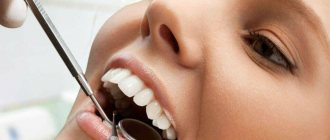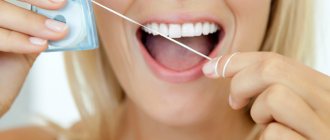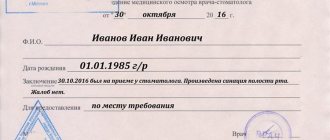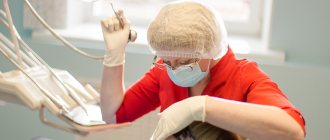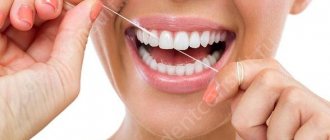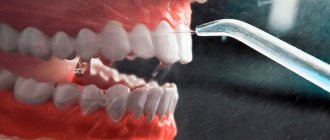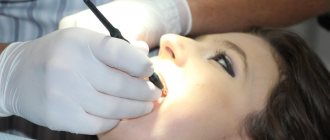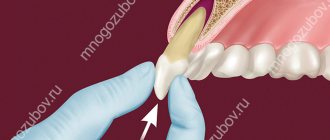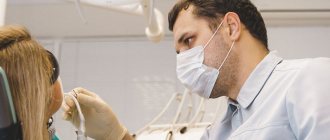Removal or extraction of a diseased tooth is a surgical procedure, after which it is necessary to carefully monitor the condition of the gums at the site of intervention. After the procedure has been carried out, it is necessary to place a special turunda into the resulting cavity. To carry out this rather complex procedure, the surgeon’s professionalism alone is not enough, because the postoperative period is quite dangerous if proper care of the affected gum is not carried out at this time. In this case, if the treatment is insufficient, some kind of infection may get into the hole and cause complications.
To avoid any problems with healing, the doctor puts a special medicine in the socket of the extracted tooth. With its help, the wound is protected from infections and external influences. What medicine is put into the hole after tooth extraction? Let's talk about this in the article.
Requirements for dressing material in dentistry
After tooth extraction, the dentist gives each patient simple but significant recommendations, compliance with which will promote rapid healing of the wound and reconstruction of damaged tissue.
One of the following recommendations is not to remove the gauze swab that the surgeon placed there from the hole for a certain period of time. This tampon acts as a compress, compressing the edges of the hole and absorbing blood.
Tooth removal is a surgical intervention, albeit in a minimal area. Any operation is not complete without compromising the integrity of the tissue, which inevitably results in bleeding.
The surgeon places a sterile gauze pad on the site of the extracted tooth to stop capillary bleeding.
A blood clot begins to form under the tampon, which will protect the wound from the penetration of pathogens.
Important! If the operation was not severe (for example, a loose tooth was removed), and the hole literally does not bleed, there is no need to apply a tampon. This also happens in cases where blood clotting factors lead to the rapid formation of a clot.
The operation does not always go smoothly.
In some cases (for example, after the removal of a wisdom tooth), the area of damaged tissue is very large and the wound is deep, and in this case a regular gauze swab will not cope with heavy bleeding. In these cases, the dentist can use iodoform turunda. It is gauze soaked in a disinfectant solution and folded in a special way.
Reference! Iodoform is a substance obtained from ethanol or acetone. Widely used in surgery as an antiseptic.
The turunda is placed in the hole, folded from one edge to the other, and pressed tightly. The medical worker places a gauze pad over the turunda and asks the patient to squeeze it with his teeth for 15-30 minutes to make sure there is no bleeding. If blood does not ooze through the turunda, the patient is released into housing.
Photo 1. Gauze, twisted into a tourniquet and soaked in an antiseptic, with a number of means to achieve the goal for placing it in the hole.
The gauze swab must be kept in the mouth for no longer than half an hour. If you leave it for much longer, it may dry to the wound, in which case you will have to soak it with chlorhexidine. This may help prevent the wound from becoming infected, but there is a high risk of not removing the formed blood clot.
Important! A gauze swab soaked in blood and saliva is a nutrient medium for the reproduction and constructive activity of bacteria. This is another reason not to keep a tampon in your mouth for more than 20-30 minutes.
As for iodoform turunda, it can be removed no earlier than after 5-6 days, when the healing process of injured tissue begins. Premature exclusion is highly likely to provoke secondary bleeding.
To avoid complications such as wound infection and promote its healing, you should follow a number of recommendations:
- Stop drinking and smoking alcohol until complete healing; exclude from the diet foods that are too harsh, sour, feverish and unforgiving; Do not allow the wound to warm up, do not apply spiritual compresses, do not visit baths and saunas; Postpone sports activities and try to get by without physical fatigue; Don’t forget about oral hygiene, but brush your teeth with increased precautions; Use all medications prescribed by a medical professional strictly according to instructions.
Required video
Watch the video in which a medical professional explains in detail what it is necessary to perform a tooth extraction.
To stop bleeding, a pressure bandage must be applied to the various wounds found. In the case of a wound at the site of an extracted tooth, this function is performed by a sterile gauze swab or iodoform turunda.
The doctor begins treatment by washing the socket and treating it with antiseptic solutions, and then cleans the socket from the remains of the blood clot using a surgical curette. Then the wound is dried with a gauze swab and treated with an anesthetic and antibacterial agents. The wound is covered with a bandage, which is designed to protect the open surface of the wound from possible biological, chemical or mechanical irritants. To check the possibility of detecting pieces of the extracted tooth in the socket, an x-ray can first be taken.
The procedure for cleaning the hole as a whole is carried out according to the following scheme:
- Local anesthesia is performed;
- The well is washed with an antiseptic solution (hydrogen peroxide solution 3%, chlorhexidine 0.05% or furatsilin 0.02%), and food debris and necrotic masses are removed;
- If there are foreign bodies in the hole (root fragments, cysts and granulomas), they are removed using special instruments;
- After cleaning the hole, it is treated with antiseptic solutions, dried with a sterile gauze swab, and turunda with an antiseptic and an anesthetic is injected into it. With a mild degree of inflammation, a turunda may not be necessary; thorough cleansing of the hole and subsequent care for it is sufficient;
- In case of a pronounced necrotic process in the hole, rinsing and application with trypsin is carried out - this is an enzyme preparation that accelerates the breakdown of dead tissue. Trypsin has anti-inflammatory and anti-edematous effects, helps clean the socket from necrotic masses and pus;
- After completing all the manipulations, the patient goes home, the doctor appoints appointment days when he needs to come for antiseptic treatment of the hole and change the turunda, if one has been installed. If necessary, a course of antibiotics is prescribed.
For alveolitis, antiseptic baths (not rinsing) with solutions of chlorhexidine 0.05% or miramistin 0.01%, which can be purchased ready-made at the pharmacy, are effective. When performing baths, the solution is taken into the mouth and held for several minutes, then carefully spat out. To relieve pain and reduce the degree of inflammation, nimesulide or ibuprofen are prescribed.
To prevent the turunda from falling out of the socket, during treatment you need to eat soft, pureed food and do not chew on the sore side. If the turunda does fall out, you need to rinse your mouth with chlorhexidine solution and immediately consult a doctor.
If this is not possible, you should rinse the hole yourself from food debris: to do this, bite off the sharp tip of the needle from a 5 ml syringe, bend it a little, and disinfect it with pure alcohol. A chlorhexidine solution is drawn into the syringe, the needle is inserted into the hole (not too deep) and the piston is pressed intensely to create a liquid pressure that can remove food debris.
All cases of alveolitis treatment are individual, so it may be necessary to visit the dentist up to several times.
With a favorable course of the healing process, the pain goes away, and the inflammatory process gradually subsides and disappears after a few days.
If the process, despite the procedures performed, progresses, then after antiseptics, gauze tampons soaked in propolis tincture or camvorophenol solution (10%) are inserted into the hole. A tetracycline-prednisolone cone inserted into the well has a good antibacterial effect.
The main criteria for assessing the quality of dental dressings are:
- compatibility with medications applied to the bandage;
- resistance to oral microflora;
- possessing sufficiently high organoleptic properties - acceptable odor and appearance.
We invite you to familiarize yourself with how cholisal is used to treat stomatitis in children.
The following are widely used in dentistry:
- Absorbent cotton wool is used in therapeutic dentistry to dry the patient’s oral cavity during treatment. Cotton rolls are formed by twisting the material onto the handle of any dental instrument.
- White gauze is used to make napkins, balls, and strips for tamponade. The main condition is that the edges of the gauze are folded into the middle - this prevents fibers from getting into the wound. Used as a drying material for wounds.
The dressing material must be sterilized before use.
Gum dressings are composed of:
- soft - ointments, gels (actovegin, solcoseryl) - applied in a thin layer to the wound surface. This category includes bandages made of cotton wool, gauze, bandages;
- semi-solid - are made by applying a mixture of dentin paste and ointment to the prepared tissue surface. The bandage is applied to the wound and fixed by compressing the teeth. After 6 - 7 minutes it hardens and is securely attached to the desired area;
- solid - septopack (ready-made product) or independently prepared using dentol, repin. The components have a high degree of biological compatibility with the mucous membrane, their use significantly accelerates the wound healing process;
- collagen films – have anesthetic and antiseptic properties, promote rapid regeneration of soft tissues of the oral cavity;
- adhesive - are non-toxic compositions based on polyurethane. Once on the mucous membrane, the material polymerizes, creating a plastic, porous film.
Dressings are prescribed for the following indications:
- after surgery – when there is a need to protect the wound surface from the effects of the external environment or to protect the mucous membrane from damage by suture material (monofilament);
- for medicinal purposes - periodontal dressings help to increase the effectiveness of the treatment provided, protecting the drugs introduced into the periodontal pockets from being washed out by saliva, and contribute to their prolonged action;
- tamponade – used after tooth extraction to prevent bleeding. Iodoform gauze turunda is made from a strip of gauze soaked in a special solution that has an antiseptic effect on the wound.
The main rule should be noted - the presence of a strong inflammatory process and the release of purulent exudate from the wound is a direct contraindication for applying bandages.
Depending on the properties and purposes, the duration of wearing the bandage is determined:
- with a therapeutic effect - from 2-3 hours to 3-4 days. They mainly use gauze and bandages, applying the necessary drugs that have antimicrobial and anti-inflammatory properties to them;
- for protection purposes, adhesive, semi-solid and hard dressings are often used, capable of fixing the application for 4-7 days;
- collagen films – have the possibility of the longest rehabilitation period (up to 20 days). Can be used as a bandage after surgery and as an independent treatment for bedsores from dentures.
Use of dressings in dentistry
Dressings are prescribed for the following indications:
- after surgery - when there is a need to protect the wound surface from the effects of the external environment or to protect the mucous membrane from damage by suture material (monofilament);
- for medicinal purposes - periodontal dressings help to increase the effectiveness of the treatment provided, protecting the drugs introduced into the periodontal pockets from being washed out by saliva, and contribute to their prolonged action;
- tamponade - used after tooth extraction to prevent bleeding. Iodoform gauze turunda is made from a strip of gauze soaked in a special solution that has an antiseptic effect on the wound.
The main rule should be noted - the presence of a strong inflammatory process and the release of purulent exudate from the wound is a direct contraindication for applying bandages.
General overview
Turunda in dentistry is a piece of gauze that is soaked in iodoform. This is an antiseptic substance that has a characteristic odor and taste. Iodoform is yellow in color, so the impregnated materials have a light yellow tint.
Also called turundas are cotton or gauze swabs that are temporarily placed with a medicinal substance in the tooth socket.
Turunda is used in different cases, but its main tasks are as follows:
- stop bleeding;
- accelerate wound healing in the hole;
- minimize drying out of the hole;
- prevent the growth of bacteria in the hole;
- for abscesses - to remove pus.
If bleeding does not stop for a long time after tooth extraction, then installing a tampon with medicine is a mandatory process.
Possible complications
In cases where the removal of the wisdom tooth hood was carried out late, there is a possibility of the occurrence of a disease such as stomatitis, which is very difficult to resolve. Sometimes such surgical intervention turns out to be ineffective and the hood appears again. Then the question arises about wisdom tooth removal.
Laser treatment of pericoronitis is possible. This treatment is less traumatic, eliminates bleeding and complications, since the laser seals the vessels and is absolutely sterile.
Procedures for continuing treatment at home
Treatment of alveolitis at home is carried out when acute symptoms have been eliminated, antiseptic turundas are no longer needed and the goal is to speed up the healing of the hole. For this use:
- Mouth rinses with infusions of chamomile, calendula, and sage. These medicinal plants have anti-inflammatory properties and accelerate healing processes. Rinsing is carried out several times during the day, always after meals.
- Applications with dental adhesive paste Solcoseryl. The drug belongs to the group of tissue regeneration stimulators: it accelerates healing, improves the supply of cells with oxygen and nutrients. The paste has a pleasant mint taste and contains the anesthetic component polidocanol 600. To properly apply the paste, you need to dry the hole with a gauze swab and fill it with Solcoseryl, lightly moisten the paste with water on top. The procedure is repeated several times a day as necessary; the paste is able to protect the socket throughout the day from mechanical and chemical influences.
- Taking vitamin preparations. You can purchase any vitamin and mineral complex at the pharmacy (Vitrum, Duovit, Complivit); Vitamins are taken to increase the body's defenses and shorten the recovery period.
What painkillers can be taken in the postoperative period?
Most often, when local anesthesia wears off after a tooth extraction procedure, the patient feels pain in the area of intervention. The best way to eliminate pain is to take NSAIDs. This group of drugs is the most effective in eliminating toothache.
- The drugs "Nurofen" or "Ibuprofen" cope well with pain after surgery. It is necessary to take the drug 500-800 mg three to four times a day, depending on the intensity of the pain.
- "Ketorol" is one of the most effective and powerful drugs from the NSAID group, which can eliminate pain after the procedure in a fairly short time. It is also used two tablets three to four times throughout the day.
Additional physiotherapy treatment (click to expand)
Physiotherapeutic treatment is an important addition to drug therapy; with the help of physiotherapy, the intensity of inflammation can be significantly reduced and healing time can be accelerated. For alveolitis, the following techniques are used:
- UV therapy - the hole is irradiated with short-wave ultraviolet light, which kills pathogenic microorganisms and reduces the level of inflammation.
- SMV therapy is a method of treatment with an electromagnetic field, based on the effect of centimeter waves on the area of inflammation. The procedure helps improve blood circulation and metabolism, due to which toxic substances are removed from tissues faster and regeneration processes are accelerated. SMV therapy also has an analgesic effect.
- UHF therapy – the body is exposed to a high-frequency electromagnetic field. For alveolitis, UHF therapy is used if the patient's regional lymph nodes are enlarged.
- Electrophoresis – medications are injected into inflamed tissue using electrical impulses. For post-extraction alveolitis, electrophoresis is used to reduce pain. For this purpose, solutions of novocaine, lidocaine, trimecaine are used.
- Fluctuarization is a treatment technique with pulsed currents of a sinusoidal shape with a low frequency. As a result of the procedure, blood circulation and lymph flow improves, swelling resolves, and the level of inflammation decreases.
- Laser therapy - the hole is exposed to infrared laser radiation, which has an anti-inflammatory effect, reduces swelling and redness of soft tissues, and accelerates healing.
Manufacturing
To make turunda for dental purposes, you need to know the proportions of dilution of iodoform, since this substance has a crystalline structure. Iodoform does not mix well with ordinary water. Therefore, it practically does not dissolve.
Medical ether is used to fill wounds after tooth extraction. The main thing is to maintain the proportion - 1 part iodoform to 10 parts ether.
It is not recommended to store the prepared solution, as it loses its properties. It is important to prepare the exact amount of soluble iodoform for one or more turundas.
For the turunda itself, cut out a small gauze ribbon. Its length can be different, because it all depends on the depth and width of the hole. The finished piece is impregnated with the composition.
Rules of application
The principle of use itself is quite simple. If we are talking about a tooth socket after tooth extraction, then the turunda is pre-twisted in the form of a tourniquet.
It is important that it completely reaches the bottom of the hole. If there is free space left in the hole, then this is dangerous due to the development of inflammation due to the active proliferation of bacteria in the blood clot. Installation algorithm:
- A thorough examination of the hole. There should be no bone fragments left in it, because this can cause pus and inflammation.
- Turunda is introduced into the cleaned hole so that it “sits” tightly over the entire area.
- Once it is fully seated, the patient should bite down on it well to ensure that any remaining voids are filled.
After installation, the doctor must indicate the exact time at which the gauze cannot be removed. In case of inflammatory processes, medications can also be placed in the hole along with soaked gauze. In this case, you cannot remove the turunda for 1-2 weeks, but it all depends on the situation.
If the tooth extraction was successful, then the hole is simply “closed” with a sterile gauze swab. It can be removed after 20-30 minutes.
We invite you to familiarize yourself with Pulpitis and periodontitis | tssdent
If you keep such a tampon for more than the specified time, it will become a real provocateur for the growth of bacteria. In addition, it will prevent the formation of a clot.
After removal, it is important to follow all doctor's recommendations. It is important to ensure that re-bleeding does not occur. This often happens if the patient is taking blood thinning drugs.
Treatment of pericoronitis
It happens that there is not enough space for a tooth to form and it grows in the wrong direction, does not take part in food processing, and destroys the neighboring tooth. In this case, the wisdom tooth is removed.
Removing the wisdom tooth hood.
The main task is to remove the free space above the tooth, into which food gets in and microorganisms multiply. The surgical intervention is not very difficult and is carried out with the use of local anesthetic. Removing the hood has virtually no contraindications and does not pose a risk to the life and health of the patient.
Stages of removing a hood over a wisdom tooth.
- explaining the operation sequence to the patient
- administration of local anesthetics
- carrying out resection (removal) of tissue protruding above the tooth
- prevent bleeding, wash the wound
- apply iodoform turunda or Alvogel.
At the end of the operation, the surgeon explains to the patient how to care for the oral cavity and releases him until the next appointment. After resection, disinfecting baths of myromistin, water-salt solution or chlorhexidine 0.05% are prescribed. Antibiotic therapy is indicated on an individual basis for patients with purulent inflammatory processes, in order to prevent complications in the future.
Complications of alveolitis
If alveolitis is not treated in a timely manner, the following complications may develop:
- Odontogenic sinusitis is an inflammation of the maxillary sinus caused by the spread of infection from the inflamed sockets after the removal of premolars or molars of the upper jaw;
- Phlegmon - purulent inflammation spreads to the surrounding soft tissues;
- Acute periostitis - pus accumulates in the periosteum area;
- Odontogenic osteomyelitis is a purulent-necrotic lesion of the jaw bone;
- Sepsis - an infection enters the bloodstream, causing it to become infected.
Alveolitis itself is not so dangerous, but its complications are life-threatening. Therefore, if you notice symptoms of alveolitis, contact your doctor immediately.
Contraindications
There are no absolute contraindications for use, but it is important to know whether the patient has an allergic reaction to iodoform.
To check, just apply a small amount of the diluted composition to the skin of your elbow or wrist. If no redness, itching or rash occurs after application, then using iodoform is completely safe.
If the patient is allergic to this substance, then it needs to be replaced, or simply use a sterile bandage.
The patient's role in the prevention of alveolitis
Prevention of alveolitis consists of following the recommendations of the attending physician after tooth extraction; it is obvious that in the matter of prevention, a large role is assigned to the patient; it depends on his actions how quickly and without consequences the healing of the hole will take place. The role of the doctor is to perform the operation in accordance with the standards of care and communicate recommendations to the patient.
According to statistics, in most cases, the cause of the development of post-extraction alveolitis is the patient’s incorrect actions after tooth extraction, ignoring the recommendations of the attending physician. After tooth extraction it is prohibited:
- Remove the blood clot from the socket. The blood clot that forms in the hole after tooth extraction prevents microbes from entering the wound, and the healing process under it proceeds quickly and without complications. Patients can remove the clot by touching it with the tongue, with fingers, by vigorously rinsing the mouth immediately after tooth extraction, and also while eating solid foods.
- Do hard physical work, sports, take hot baths, go to the sauna. Intense loads and elevated temperatures provoke the opening of the wound, and bleeding resumes; pathogenic microorganisms can enter the wound.
- Smoking, drinking alcohol. Bad habits lead to excessive irritation of the mucous membranes, healing of the hole is much slower, and inflammation may occur.
To speed up healing and prevent the development of inflammation in the socket, you need to:
- In the first few days after tooth extraction, review your menu, excluding spicy, too salty, sour, and hot dishes. All food should be soft, pre-chopped;
- Maintain careful oral hygiene. The presence of chronic inflammation of the gums and carious teeth in the mouth can cause infection of the socket, so after tooth extraction you need to carry out antiseptic baths (they should be prescribed by a doctor);
- After each meal, rinse your mouth with clean water to remove any remaining food; this must be done very carefully so as not to remove the blood clot covering the hole;
- Brush your teeth carefully, trying not to touch the socket with the brush.
Actions of the dental surgeon to exclude alveolitis:
- Thoroughly clean the socket so as not to leave a tooth fragment or cyst in it. After extracting a tooth, especially a damaged one, a control x-ray of the socket is often taken;
- Be careful and avoid injury. The tooth extraction was accompanied by bone injury due to the inept actions of the doctor. Usually the bone is injured during complex extraction, when tooth extraction cannot be carried out using conventional instruments. Difficult procedures include the removal of unerupted and incorrectly positioned wisdom teeth, multi-rooted teeth, and teeth with curved or destroyed roots. An inexperienced doctor may not understand the situation and damage the bone;
- Control during anesthesia. An overdose of anesthetic leads to a sharp decrease in the amount of blood released after tooth extraction and insufficient formation of a blood clot;
- Prescribing appropriate antibacterial drugs, especially if the tooth extraction was difficult or was carried out against the background of purulent inflammation.
Therefore, it is very important to seek help from competent and experienced specialists who are fully familiar with all the intricacies of the tooth extraction procedure.
Sometimes alveolitis can develop despite preventive measures taken due to certain reasons. These reasons include:
- Reduced immunity of the patient, inability of tissues to regenerate;
- Tendency to bleed, resulting in a blood clot not forming;
- An increase in the amount of the hormone estrogen in women when taking hormonal contraceptives or certain diseases, which leads to the destruction of a blood clot.
A timely visit to the dentist if alveolitis develops is the key to a quick cure. Patients of our clinic who have undergone tooth extraction surgery receive detailed recommendations on oral care; if they are strictly followed, the likelihood of developing alveolitis is excluded.
What should the patient do after the procedure?
After the procedure has been completed, the specialist must carefully explain to the patient his next steps, as well as the rules for caring for the wound during the healing period.
- The turunda or cotton wool that was left by the surgeon in the hole does not need to be removed by yourself. If the tampon placed by the doctor falls out ahead of schedule, the patient must return to the specialist to install a new turunda. If this is not done, an infection may enter the wound cavity.
- If after the procedure the cheek is very swollen, you can apply ice or a cold compress to it. After this procedure, it is forbidden to heat the affected area and apply hot compresses.
- You can eat food after tooth extraction only two hours after the procedure. It is recommended to eat only liquid and light foods that do not contain solid pieces.
- A blood clot forms in the hole where the tooth was pulled out. It is prohibited to remove it or touch it. The first time after the procedure, you must brush your teeth with caution and do not use any rinses.
- For 7 days after tooth extraction, it is prohibited to carry out other interventions in the oral cavity.
- During the healing period, it is not recommended to overheat, for example, take a steam bath, and also exercise with caution. It is also strongly recommended to stop drinking alcoholic beverages and smoking cigarettes for two days after the procedure.
- After tooth extraction, pain often occurs at the extraction site. In this case, quite often not only the hole, but the whole head as a whole can hurt. Also, the patient may experience pain while eating, regardless of which side of the teeth he chews on. Experts recommend coping with these problems with the help of painkillers, such as Pentalgin or Tempalgin. In this case, it is advisable to take the drug in combination with Suprastin.
Despite the fact that there is medicine in the hole, a person may still feel pain and some burning. Such unpleasant sensations will have to be ignored.
Important ! If the sensations intensify, it is recommended to consult a doctor again so that he can examine the wound and, if necessary, take action.
Features and shelf life
Store ready-made cotton balls or gauze strips in an extremely sterile environment. They can be stored along with bandages and napkins. The ideal storage place would be a sterile container, but it is still not entirely reliable, as it often opens.
For convenience, dentists pack tampons and turundas in separate paper bags, which must be sterilized in an autoclave.
It is appropriate to sterilize immediately before using the material, since over time, bacteria can get on cotton wool, bandages or gauze. The shelf life of sterilized turunda is on average 7 days.
The video provides additional information on the topic of the article.
Iodoform turunda after tooth extraction when it is removed
- When the question arises about tooth extraction, the patient is interested in knowing what the doctor is doing and whether everything is in order.
- Asking questions with your mouth open is inconvenient, and it is impossible to predict the doctor’s actions in advance.
- Most specialists do not consider it necessary to educate the patient about the intricacies of the work.
- In this article we will try to clearly explain one of the ways to stop bleeding after tooth extraction.
General overview
After the doctor finishes removing the tooth, the gums will bleed. This is normal and the bleeding usually stops after a few minutes.
But there are exceptions to any rule, and it often happens that the bleeding does not stop on its own.
In cases where blood comes from deep within the socket, iodoform turunda is used. The effect of its hemostatic use is achieved due to its compaction and blocking the possibility of blood flow.
In addition to the hemostatic effect, turunda, due to the presence of iodoform, has disinfectant properties.
We suggest you familiarize yourself with What is a loose throat in a child?
Also, in some cases, iodoform turunda can be used for drainage of the periapical region for the purpose of outflow of inflammatory products.
Manufacturing
Iodoform turunda is made from sterile gauze and soaked in a special solution. Components of the impregnation solution:
- iodoform – 50 parts;
- ether – 70 parts;
- ethyl alcohol – 30 parts;
- glycerin – 15 parts.
A strip of sterile gauze 10-15 mm wide is immersed in a pre-prepared solution. After this, the gauze is pulled out and left to dry. When the ether evaporates, the gauze turns bright yellow and is ready for use.
You can also buy an iodoform bandage at a pharmacy. For ease of storage, it is sold in cans and has a width of 20-25 mm and a length of up to 5 meters.
Rules of application
The process of stopping bleeding begins with removing any remaining blood clots from the socket. The field is treated with saline or chlorhexidine solution and dried with cotton swabs.
Then the hole is filled with turunda, starting from the very bottom. In the process of filling the hole, the turunda is folded from one edge to the other and pressed tightly.
In cases where a tooth with several roots was removed, each hole is filled separately. To prevent the turunda from falling out, the edges of the wound are pressed against each other, placing sutures at a distance of 5-7 mm from the edge of the gum.
If there is no bleeding, the gauze pad is removed and the patient can go home. If the bleeding is not stopped, the packing procedure is repeated.
The turunda is removed 5-6 days after the healing process of the gum walls begins. If you remove it earlier, re-bleeding is possible.
Typically, healing of the hole occurs according to the following scenario:
- On days 3-4, granulation tissue begins to develop. White crusts on this tissue are newly formed epithelium. It is highly undesirable to damage it in any way.
- After 14 days, the hole is completely overgrown with granulation tissue. The formation of bone tissue begins on the bottom and side walls.
- After 45 days, bone tissue fills the socket.
- From 45 to 90 days, bone tissue is transformed into mature bone.
- 4-6 months. The gum is completely healed, and on x-ray the bone tissue is indistinguishable from the entire jawbone.
Contraindications
- As such, there are no contraindications to the use of this method of stopping bleeding, with the exception of hypersensitivity to iodoform.
- However, science does not stand still and more and more experts are inclined to conclude that the use of turunda is irrational due to the fact that the effect of iodoform ceases after a few hours.
- It is then washed out of the gauze, and a foreign object in the hole can lead to infection.
Instead of outdated methods, the use of modern medications is proposed.
Removal of a tooth is accompanied by injury to the mucous membrane and bone in which it was located. But if the removal was easy and the patient follows the doctor’s instructions, then the wound will heal on its own. An important condition for rapid healing of the bone at the site of the tooth is the appearance and preservation of a blood clot, which:
- prevents infection from entering the wound;
- is the basis for the appearance of a bone scar at the site of an extracted tooth;
- blood has a local protective effect because it contains antibodies and cells of the immune system.
It is important that a blood clot forms without sources for its infection, which leads to inflammation of the tooth socket, despite its presence.
Turunda with iodoform are small pieces of gauze that are used for local disinfection of the socket of an extracted tooth. The dentist can place such a turunda immediately after removal if:
- tooth extraction was long and traumatic;
- if an operation was performed to remove a tooth (this is usually how impacted wisdom teeth are removed, which cannot cut through on their own, and at the same time they lie in the bones and other teeth are displaced);
- tooth extraction led to a rupture of the mucous membrane (if the tooth has massive roots and is difficult to remove, or if the broken root needs to be removed with an elevator);
- complications arose during removal (continuation of the maxillary sinus by the root of the tooth, separation of the tubercle of the upper jaw);
- if after removal inflammation of the tooth socket develops - alveolitis.
- A pocket of infection remained in the bone. If the doctor has not inspected the socket, then granulations, cystic sacs, fragments of tooth roots or the interradicular bone septum may remain in it, which become a source of infection or permanently injure the clot.
- The removal was traumatic, and this caused tissue swelling.
- The patient suffers from blood diseases in which blood clotting is impaired (true and pseudohemophilias, Scheinlein-Henoch disease, menstruation (in women), thrombocytopenia, etc.).
- The patient is taking anticoagulant medications due to heart or vascular disease.
- The doctor uses an anesthetic with adrenaline, which causes vasoconstriction and deterioration of blood supply in the socket area.
- The use of painkillers with adrenaline in people with initially narrowed vascular lumen (with hypertension, atherosclerosis, diabetes mellitus).
- Failure to follow the doctor’s recommendations: after removal, the patient rinsed out the clot, drank alcohol, an anti-clotting medicine, did not take into account the recommendations regarding the diet (eats too hot food, chews on the side of the extracted tooth, eats solid food).
Basically, alveolitis occurs in two scenarios:
- According to the “dry socket” type - only the periosteum and mucous membrane of the socket are involved in the process: Serous - there is no discharge or clot in the socket.
- Purulent - accompanied by the appearance of pus from the socket without melting the alveolar bone;
- Ulcerative-necrotic - caused by infection of aggressive flora (fusobacterium and spirillum). Necrotic deposits appear on the surface of the mucous membrane and socket, and when removed, ulcers form. It occurs with an increase in body temperature and severe soreness of the mucous membrane.
What signs indicate the inevitability of removal of a mobile tooth in an adult patient?
The following publication contains detailed information about indications for the removal of baby teeth in children.
Tooth extraction is a procedure that requires an appropriate period of rehabilitation.
One of the most important points is the use of turunda.
It is the installation of a turunda that allows you to stop bleeding and prevent the occurrence of an inflammatory process in the tooth socket.
General overview
Also called turundas are cotton or gauze swabs that are temporarily placed with a medicinal substance in the tooth socket.
Manufacturing
We suggest you read: Pain after wisdom tooth removal, what to do
How popular is the service of teeth removal at home, and what patients should know about the procedure.
Let's talk here about the indications for removing a mobile tooth.
Rules of application
It is important that it completely reaches the bottom of the hole. If there is free space left in the hole, then this is dangerous due to the development of inflammation due to the active proliferation of bacteria in the blood clot.
Basic rules of oral hygiene after tooth extraction
In order to prevent possible complications after the procedure, you need to strictly follow the rules of oral hygiene.
- Two to three days after tooth extraction, the mouth can be rinsed with a soda solution. It is diluted in the ratio of one teaspoon of soda to one glass of warm water. You can also rinse with other means that help faster healing, for example, Chlorhexidine. Rinsing should be done very carefully, as it can damage the integrity of the blood clot that has formed in the hole. Gentle rinsing is carried out by drawing a solution into the oral cavity. After this, you just need to hold the solution in your mouth for a while and then spit it out. This rinse will not harm the blood clot.
- Rinsing is necessary to prevent infection or food particles from entering the wound, which can cause suppuration.
There are a number of symptoms that indicate the presence of complications in the postoperative period. Among them:
- pain that does not subside for several days after the procedure. In the presence of such pain, even various painkillers cannot help;
- the patient notes continuous bleeding from the wound. In this case, the blood has a bright scarlet hue;
- The patient’s body temperature rises and remains for 24 hours after the tooth extraction procedure;
- slight swelling of the cheek after the procedure develops into severe swelling that spreads over the entire side of the face. The patient feels weak and drowsy;
- pus is leaking from the wound or the area around the wound has begun to darken. In this case, after a few days the patient experiences a persistent putrid odor from the mouth;
- the dentition may become mobile;
- divergence of applied sutures.
Important ! If the patient notices any of the listed symptoms, in this case it is necessary to urgently consult a doctor. If such complications are left unattended, they will soon develop into more serious pathologies that can threaten not only the patient’s health, but also his life.

